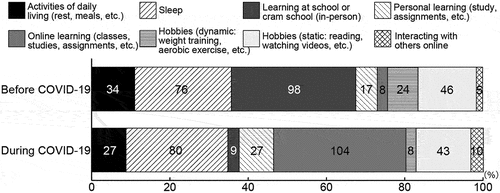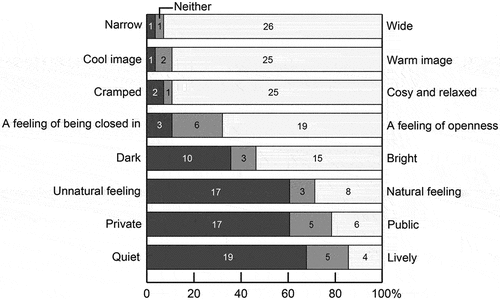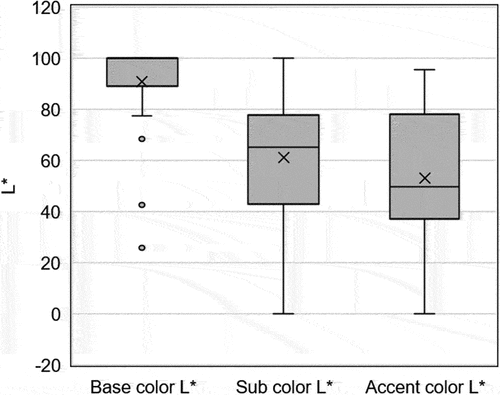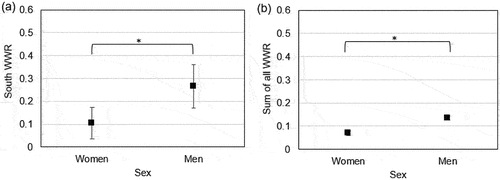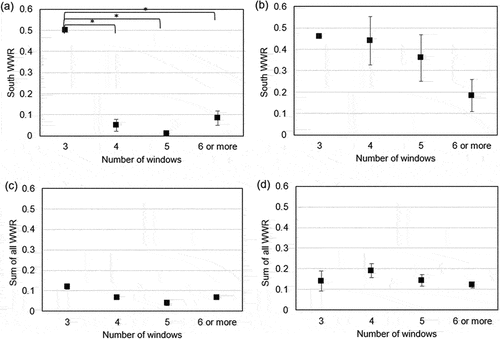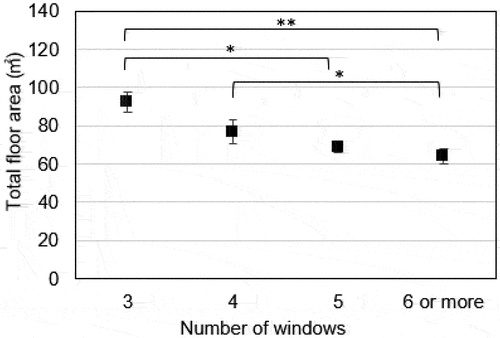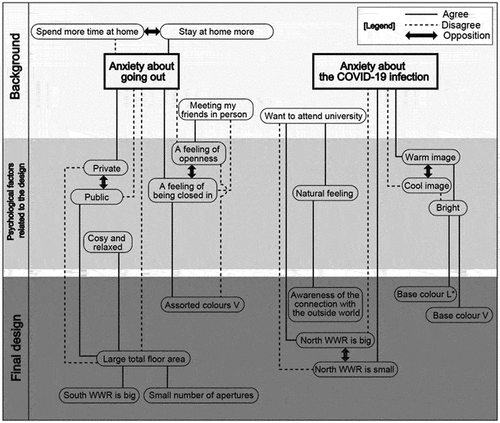 ?Mathematical formulae have been encoded as MathML and are displayed in this HTML version using MathJax in order to improve their display. Uncheck the box to turn MathJax off. This feature requires Javascript. Click on a formula to zoom.
?Mathematical formulae have been encoded as MathML and are displayed in this HTML version using MathJax in order to improve their display. Uncheck the box to turn MathJax off. This feature requires Javascript. Click on a formula to zoom.ABSTRACT
During the coronavirus disease (COVID-19) pandemic, people worldwide were psychologically affected by being limited to mostly indoor, at-home activities. This study sought to clarify how COVID-19-related psychological states and anxiety affect changes in designs and perceptions of living environments. Hence, this study assigned a housing design task to architecture students – considerations included windows (window-to-wall ratio), lighting plan, color plan, and floor area – and conducted a survey regarding the related deliverables. The results showed that anxiety about going out affected perceptions of openness and publicity, whereas fear of COVID-19 infection affected impressions of space, brightness, and naturalness. These psychological effects are reflected in the total floor area, window area, and color planning. These effects reveal how the psychological state of the designer affects the spatial elements in architectural design.
Abbreviations: SD method - Semantic differential method SD - Standard deviation WWR - Window-to-wall ratio Df value – Degrees of freedom value
Graphical Abstract
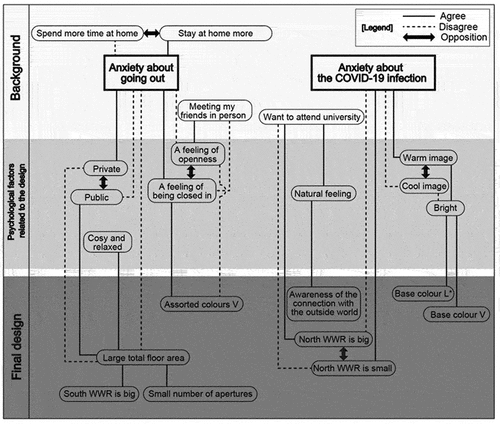
1. Introduction
The restrictions on going out due to the coronavirus disease (COVID-19) pandemic have forced people in many countries to stay home and have had a significant psychological impact (Amerio et al. Citation2020; Motohashi and Matsuoka Citation2020; Rossi et al. Citation2020; Tsamakis et al. Citation2020). For example, for many, having to stay home all day has been reported to worsen family relationships (the pandemic increased domestic violence calls by 7.5% between March and May 2020 in Japan) (Leslie and Wilson Citation2020). Additionally, loneliness increased in people living by themselves who did not see anyone else (Berg-Weger and Morley Citation2020; Henry Citation2020). Furthermore, some people developed immense anxiety about going out and now find it challenging to leave their homes. Furthermore, the cramped housing conditions in Japan’s major cities are commonly cited as a major problem (Motohashi and Matsuoka Citation2020).
Previous studies have predicted that the coronavirus outbreak will require changes in cities and construction environments (Sharifi and Khavarian-Garmsir Citation2020) that emphasize COVID-19 infection prevention (Megahed and Ghoneim Citation2020). Future housing designs are also predicted to change after the COVID-19 pandemic (Megahed and Ghoneim Citation2020), but there is a lack of clear evidence to support these predictions. Therefore, it is necessary to clarify which aspects of the COVID-19 pandemic have affected housing designers.
1.1. Impact of the COVID-19 pandemic on changes to housing requirements and the psychological state of designers
As mentioned above, throughout the COVID-19 pandemic, people needed to reconsider how they live. Particularly significant changes in daily life include increased time spent at home and a new mix of private and public spaces due to teleworking (Okubo Citation2020). Going forward, these lifestyle transitions are expected to result in significant changes in the functional requirements for housing. In response to these social adjustments, changes in housing design are expected from developers and designers (Oxman Citation2004; Razzouk and Shute Citation2012).
There has been considerable research on housing and health. To date, however, there is no general consensus on the definition of a “healthy home,” and significant gaps remain in our knowledge of how housing conditions affect health. Some studies have explored the relationship between housing conditions and health, focusing on mental health, sleep quality, indoor air quality, home safety, accessibility, obesity, mold growth, damp heat conditions, energy consumption, and perceptions of crime as important factors affecting housing quality. It is clear that housing is complex and housing design involves consideration of various factors, including air quality, sound environment, safety, and neighborhood environment (Bonnefoy Citation2007). In addition, a critical review of the existing research on housing and mental health, taking into account housing type (e.g., single-family vs. multi-family housing), floor height, and housing quality (e.g., in terms of structural damage), presents sufficient evidence to suggest that housing is important for psychological health, particularly in children (Evans, Wells, and Moch Citation2003). In addition, user preferences for housing have become increasingly complex in recent years as the lifestyles of occupants have rapidly changed. In housing, especially in large houses that are not custom-designed to meet the needs of individual occupants, discrepancies between occupants’ living needs and design occur at various levels (Wong Citation2010). These studies show a profound link between housing and quality of life, and we need to understand the psychological consequences that people have experienced in the context of the COVID-19 pandemic and the factors they look for in the design of their living environment.
Prior research has emphasized the role of learning in the design process for architecture students, the target population of this study (Atman et al. Citation1999). Students who are beginning to learn design must also learn methods and develop thoughts on how to create designs, which largely reflects the students’ social context and psychological states.
Thus far, no study has focused on the relationship between the social and psychological states of designers and their designs. However, much research has been conducted on the psychological environmental effects of windows, color planning, lighting, and color temperature. Studies have investigated how spatial openings affect people, including their psychological responses to windowless environments (for instance, Hollister (Citation1968) mentioned another investigator who examined employees of factories in Thuringia and found a higher amount of sick leave due to colds, stomach disorders, and nervous disorders in windowless factories); whether general levels of lighting, sunlight transmission and visibility can mitigate the negative effects of work stress; the direct and indirect effects of workplace windows on work satisfaction and general well-being (Leather et al. Citation1998); and children’s behavior and health in classrooms with and without windows (Küller and Lindsten Citation1992).
Regarding the relationship between lighting, color temperature, and psychology, the effect of the color temperature of the light source on mental activity level has been investigated; it was found that simple reaction times were more active at a color temperature of 7500 K than 3000 K (Deguchi and Sato Citation1992). Additionally, regarding the relationship between student learning and lighting, focus lighting led to a higher percentage of oral reading fluency performance (36%) than control lighting (17%) (Mott et al. Citation2012). Regarding the effect of color on emotions, powerful and consistent effects of saturation and brightness on emotions were demonstrated (Valdez and Mehrabian Citation1994). It has also been reported that color and colored environments affect moods and emotions and produce negative or positive perceptions of a given environment or task (Jalil, Yunus, and Said Citation2012).
1.2. Hypotheses and purpose
This study aimed to examine how changes in the living environment due to the COVID-19 pandemic and fear related to infectious diseases have affected housing designs. It aimed to determine the physical and psychological factors for analysis based on student designs and survey results. Thus, the following four hypotheses were formulated.
●Hypothesis 1: Comparing the pre-pandemic and pandemic periods, there is a difference in the impact on people’s lives, such as increased living time at home.
●Hypothesis 2: The COVID-19 pandemic has implications for current designs of housing, such as the size of the space and the feeling of openness.
●Hypothesis 3: The COVID-19 pandemic has influenced indoor color planning, lighting design, and color temperature design.
●Hypothesis 4: The changes in lifestyles and work caused by the COVID-19 pandemic have affected the feeling of openness due to the number and design of windows and the overall size of rooms and spaces.
2. Materials and methods
2.1. Participants
The participants of this study were 28 students (12 women, mean age = 18.5, SD = 0.74, aged 18–21 years) of the Department of Architecture at a university in Tokyo, Japan. Because 28 of the 40 students who participated in the class answered the questionnaire (response rate of 70%), the data of 28 students were analyzed. Since the onset of the COVID-19 pandemic, the university has conducted mostly online classes, although there are in-person classes for some subjects. However, this study targeted students who participated only in fully online classes. This study was conducted according to a protocol approved by Tokyo Denki University. All participants provided informed consent before the study began.
2.2. Procedure
Housing planning, design, and questionnaires were used to investigate the effects of changes in the living environment and anxiety related to infection on housing design associated with the spread of coronavirus infection. As no housing designs before COVID-19 were available, it was impossible to directly compare the contents of housing designs during COVID-19 with prior examples. Therefore, self-reported information about the participants’ psychological states and lifestyle patterns before and after the pandemic were investigated. All processes were conducted online using Zoom.
From July 8 to 29 July 2020, once a week, the authors gave an introductory lecture to the participants. The contents of the lecture were designed to convey only a basic knowledge of housing design. The lecture described the concepts of space volume, window planning, natural light planning, lighting, color temperature, interior (interior materials, coloring), furniture, and small items. On August 24, participants were asked to give a design presentation after attending a tutorial. To mitigate the potential influence of a tutor, the tutorial was conducted with the sole purpose of preventing design mistakes due to the participants being students. In other words, the authors respected the concept and design of the participants and carried out esquisses (preliminary sketches).
The participants made their models from August 24 to 27 (S = 1:30) and submitted the final design proposals (A3, 1–2 pages). Between August 27 and 29, participants completed a questionnaire (see later in this section) on their design proposals using an online survey tool (Google Forms). The questionnaire took about 40 minutes. For the statistical analysis, JMP13.0 (SAS Institute Inc.) software was used. The level of statistical significance (p) was set to 0.05 and 0.01. The influence of participants’ psychological states on their designs was evaluated by analyzing the design proposals and survey results using t-tests, analysis of variance (ANOVA), correlation analysis, and χ2 tests.
2.3. Housing design
Housing planning and design had the following conditions. Participants were asked to create a concept, drawn design, color design, lighting design, window design, furniture layout, and small items layout under the theme of the house in which they would like to live. The house volume was limited to 250–300 m3.
The following contents were included in the final design proposal submissions (A3, 1–2 pages): title, concept of housing design, color scheme, material, lighting design, furniture layout, total floor area and window area calculation, plan, cross-sectional view (S = 1:30), development view (including window area), 1–2 external model photos, and 4–5 interior model photos that convey the concept well.
2.4. Questionnaire
The questionnaire items are shown in . The survey items were divided into seven categories: Q1. Current situation related to COVID-19; Q2. Activity time and sleeping time in a house before and during COVID-19; Q3. Housing design title; Q4. Lighting equipment and color temperature plan; Q5. Space evaluation in design using the 7-level semantic differential (SD) method; Q6. Window area and total floor area; and Q7. Function of space.
Table 1. Questionnaire items, contents, and options.
All surveys were conducted during the COVID-19 pandemic. Since Q2ʹs staying time and sleeping pattern before COVID-19 are lifestyle-related, it was assumed that the measurement during COVID-19 was within a range of time that they could remember accurately and that effective results could be obtained.
2.5. Definition of terms
2.5.1. Window-to-wall ratio
The window-to-wall ratio (WWR) was defined as the ratio of the total window area to the total exterior wall area. The WWR is mainly used as a reference formula for energy consumption accounting for daylighting controls, visible transmittance and glazing reduction (American Society of Heating Citation2004; Athalye et al. Citation2013; O’Connor et al. Citation1997). Therefore, in this study, the WWR was used to investigate its relationship with psychological factors. The equation of the WWR is as follows (EquationEq. 1)(1)
(1) :
Six types of WWRs were used in this study: the East WWR, West WWR, South WWR, North WWR, Ceiling WWR, and Total WWR (all five directions combined).
2.5.2. CIE 1976 L*u*v* color space
The CIE defined the CIELUV uniform color space in 1976. Since the components are L*, u*, and v*, it is called CIE1976L*u*v* and it is used to indicate color difference (International Organization for Standardization Citation2009). Symbols and abbreviated terms are as follows:
Table
To analyze the psychological evaluation according to the color plan of the space, the base color, sub color, and accent color used in the housing design were used in the final design submitted. Using Photoshop CC 2019 (Adobe), the RGB, V and C of the base color, sub color, and accent color were extracted. By substituting RGB in EquationEquation 2(2)
(2) (Fairman, Brill, and Hemmendinger Citation1997) to obtain X, Y, and Z and substituting X, Y, and Z in EquationEquations 3
(3)
(3) and Equation4
(4)
(4) (ISO, 2009) to obtain u and v, L*, u*, and v* were calculated using EquationEquations 5
(5)
(5) , Equation6
(6)
(6) , and Equation7
(7)
(7) , respectively (Fairman, Brill, and Hemmendinger Citation1997). Y, u′, and v′ describe the test color stimulus and
,
, and
describe a specified white stimulus in these formulae:
Where
3. Results
3.1. Hypothesis 1: impact of COVID-19 on people’s lives
3.1.1. Stay-at-home times and sleep times
The difference in participants’ stay-at-home times on weekdays [χ2 = 33.07, df = 5, p< 0.01] and stay-at-home times on weekends [χ2 = 24.49, df = 5, p< 0.01] showed a significant difference before and during COVID-19. During the COVID-19 pandemic, the stay-at-home period increased by more than six hours on weekdays and about five hours on weekends compared with before COVID-19. However, there was no significant difference between sleep times on weekdays [χ2 = 2.62, df = 3, p = 0.45] and sleep times on weekends [χ2 = 4.22, df = 4, p = 0.38] before and during COVID-19.
The ANOVA of changes in sleep times and sleep quality before and during COVID-19 indicated that there was no significant difference between before COVID-19 on weekdays [χ2 = 8.05, df = 6, p = 0.23], during COVID-19 on weekdays [χ2 = 4.35, df = 6, p = 0.63], before COVID-19 on weekends [χ2 = 2.58, df = 4, p = 0.63], and during COVID-19 on weekends [χ2 = 7.58, df = 8, p= 0.48]. These results confirm that sleep times and quality were not affected by COVID-19.
illustrate the differences in stay-at-home times and in activity contents before and during COVID-19. shows the differences in stay-at-home times before and during COVID-19 on weekdays and weekends. The proportion of respondents who stayed home longer than 18 hours during COVID-19 on both weekdays and weekends was high.
Figure 1. Differences in stay-at-home-times before and during COVID-19, according to weekdays and weekends.
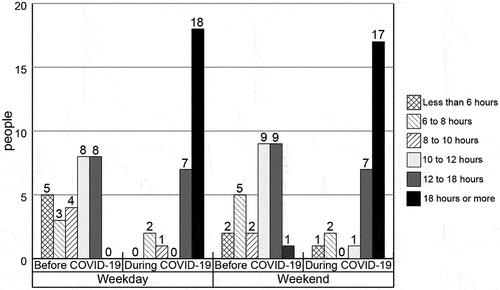
shows the differences in activities before and during COVID-19. Participants were ranked from the most time spent to the least time spent among the eight activities presented. Among the rankings of the eight items, the highest-ranked activity was given 6 points, the second-highest was given 3 points and the third-highest was given 2 points, as shown in . The results indicate significant differences in overall activity before and during COVID-19 [χ2 = 169.26, df = 7, p < 0.01], although there were no changes in the activities of daily living (rest, meals, etc.), sleep, and hobbies (static). However, personal learning (study, assignments, etc.), online learning (classes, studies, assignments, etc.), and interacting with others online increased significantly, while dynamic hobbies and learning at school (online or in-person) decreased significantly.
3.1.2. Feeling fearful about COVID-19 Infection and anxiety about going out
The relationship between feeling fearful of COVID-19 infection and going out indicated no significant difference [χ2 = 7.86, df = 4, p = 0.10] (proportions shown in ). However, the results indicated that most of the participants felt fearful and anxious.
Figure 3. The proportion of participants feeling fearful of COVID-19 infection and anxiety about going out.

A χ2 test was conducted to investigate the effects of feeling fearful of COVID-19 infection and anxiety about going out according to stay-at-home times and sleep times on weekdays and weekends. There was a significant difference between stay-at-home times on weekdays [χ2 = 27.41, df = 6, p < 0.01] and weekends [χ2 = 27.48, df = 8, p< 0.01] during COVID-19 and anxiety about going out. There was no significant difference in the other items. There was also a significant difference in stay-at-home times on weekdays and weekends before and during COVID-19, but no significant difference between stay-at-home times and feeling fearful of COVID-19 infection.
There was little difference between weekdays and weekends. Participants who were not anxious about going out on weekdays and weekends spent 11 hours at home, while participants who were anxious about going out had a sharp increase in stay-at-home-times to around 18 hours.
3.2. Hypothesis 2: effect of COVID-19 on housing space design
3.2.1. Housing space design concept and psychological evaluation
shows the results of the psychological evaluation according to the design image of housing space. More than 50% of the participants reported that they used wide spaces, warm images, “cozy and relaxed” elements, “a feeling of openness,” brightness, spaces with an “unnatural feeling,” and “private” and “quiet” spaces.
Correlation analysis was used to determine the associations between the psychological evaluation items, as shown in . In this study, Spearman’s rank correlation coefficient was used as defined by Rovai, Baker, and Ponton (Citation2013). There was a correlation of r = 0.6 for “a feeling of being closed-in–a feeling of openness, and private–public.” “Narrow–wide, cramped–cozy and relaxed,” “dark–bright, warm image–cool image,” “dark–bright, unnatural feeling–natural feeling” and “quiet–lively, private–public” showed low correlations (r = 0.3–0.5).
Table 2. Psychological evaluation according to the design image of housing space: correlations and descriptive statistics (r = Spearman’s rank correlation coefficient).
shows a benefit portfolio illustrating the relationship with the design concept, based on the relationship between the contrasting pair “a feeling of openness–a feeling of being closed-in” and the pair “private–public” having the highest correlation of the psychological evaluation items in .
Figure 5. Relationship between “a feeling of openness–a feeling of being closed-in”/“private–public” and the design concept.
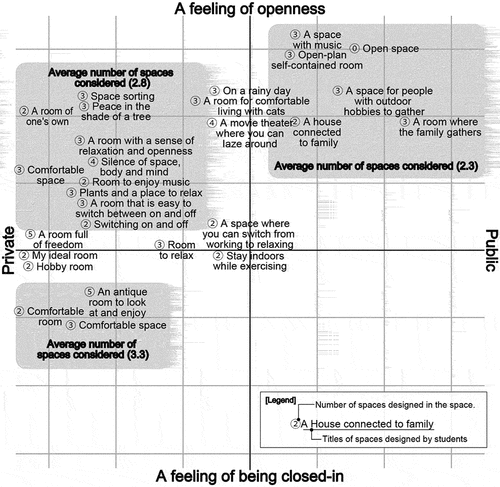
There was an approximately equal correlation between the paired items for the design concepts of “public space with a feeling of openness,” “private space with a feeling of openness,” and “private space with a feeling of being closed-in.” By contrast, there was a difference in the average number of spaces for each feature of the space.
3.2.2. Items affected by the COVID-19 situation and psychological evaluation
shows the results of the ANOVA of the psychological evaluation items according to how they were affected by the COVID-19 situation. The more fearful of COVID-19 infection the participant was, the greater the tendency for a “warm image” [F(2,25) = 3.78, p = 0.04]. The more strongly they felt “about attending university,” the more their designs tended toward spaces with “natural feeling” [F(2,25) = 3.78, p = 0.04]. People who had no anxiety about going out tended to design with “a feeling of openness” [F(2,25) = 4.74, p = 0.02], but those who had anxiety about going out designed spaces that felt more private [F(2,25) = 5.12, p = 0.01]. Furthermore, people who wanted to meet with friends in person created designs with a feeling of openness [F(2,25) = 6.55, p = 0.02].
Table 3. ANOVA for the SD method by the items affected by the COVID-19 situation.
3.2.3. Design situational awareness and a psychological evaluation of housing space
Student’s t-test was used to investigate the relationship with the psychological evaluation according to the presence or absence of design situational awareness of the housing space. The more “awareness of introducing daylight” there was, the more the “quiet” tendency appeared [t(26) = −2.41, p = 0.02]. The more “awareness of the connection with the outside world” there was, the more participants tended to design a “natural feeling” [t(26) = 2.32, p = 0.03]. The analysis of the relationship between the number of windows and WWR is shown in later in this section.
3.3. Hypothesis 3: color planning and the influence of lighting and color temperature
3.3.1. Color planning and psychological evaluation of the space
In this study, brightness was analyzed using L* and the color distribution was identified using a u*v* chromaticity diagram. shows the results of the psychological evaluation by L* (psychometric lightness), V (Value), and C (Chroma), analyzed using ANOVA. The results indicate that the higher L* [F(1,26) = 6.46, p = 0.02] and V [F(1,26) = 8.29, p< 0.01] of the base color, the “brighter” participants felt. The higher the L* [F(1,26) = 6.29, p = 0.02] and V [F(1,26) = 4.27, p = 0.05] of the base color, the more the feeling of being “cozy and relaxed” decreased. Conversely, the higher the base color C was, the more “cozy and relaxed” they felt [F(1,26) = 6.51, p = 0.02]. Meanwhile, as the V of the sub color increased, the “feeling of being closed-in” rose [F(1,26) = 4.54, p = 0.04] and as the C of the sub color increased, the more space felt “narrow” [F(1,26) = 10.73, p< 0.01].
Table 4. ANOVA for the SD method by L*, V, and C.
shows the box plot of the L* values of the base color, sub color, and accent color used in the design of the housing space. L* is psychometric lightness, which is used as an index of brightness; the higher the value, the brighter the color. The L* values of the base color came out high, whereas the L* values of the sub color and accent color were low.
shows the scatterplot of the u*v* of the base colors, sub colors, and accent colors used to design the housing space. This is a color mixing system where u* indicates red, -u* indicates green, v* indicates yellow, and -v* indicates blue. The vertex protruding to the right of the line in the graph corresponds to the red (R = 1, G = B = 0) of RGB and represents yellow, green, cyan, blue, and magenta in anticlockwise order. The center where the six lines intersect (u* = v* = 0) corresponds to black and white, indicating achromatic colors. The further away from this center point, the more vivid the color becomes.
As shown in the results for the base color u*v*in ), the base colors were primarily bright or low saturation. As shown in the results for the sub color u*v*in ), the sub colors were primarily brown and beige and created using wood. As shown in the result for the accent color u*v*in ), the accent colors tended to have relatively high saturation and various colors were used to create a focal point within the space.
3.3.2. Lighting and color temperature and psychological evaluation
The results of the psychological evaluation by color temperature were analyzed using ANOVA, showing a significant difference from the results for “bright” [F(4,73) = 2.92, p = 0.03]. In other words, “bright” was expressed using the color temperature of the lighting and when the color temperature was higher, it felt “brighter” ()). This study also found a significant difference for “warm image” in the results [F(4,73) = 7.04, p< 0.01]. In other words, it confirmed that the color temperature of the lighting was reduced to produce a “warm image” in the space ()).
Figure 8. Relationship between color temperatures and the psychological evaluation of the lighting used in the actual design; (a) dark–bright, (b) warm image–cool image.
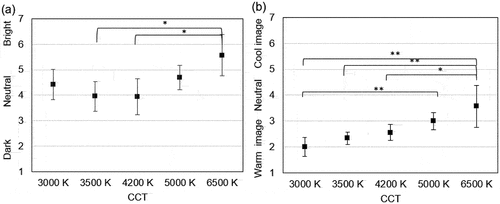
shows the correspondence analysis of the data on the types of lighting fixtures and color temperatures. The 10 types of lighting fixtures in were broadly classified into general and specific lighting. In this study, “specific lighting” refers primarily to the specific lighting used in houses, but it also includes some task lighting. The results of the correspondence analysis showed that color temperatures of 3500 K, 4200 K, and 5000 K tended to be used mainly in general lighting. In addition, color temperatures of 3000 K and 6500 K were produced using specific lighting. As such, 3000 K and 6500 K, which are extremely low and high color temperatures, respectively, created a point within a space through specific lighting.
3.4. Hypothesis 4: effect of windows and total floor area
3.4.1. Gender and window design
The results of the analysis using Student’s t-test to confirm the differences in the WWR and number of windows by gender in the housing design showed a significant difference in the South WWR [t(26) = −2.51, p = 0.02] and the sum of all the WWRs [t(26) = 2.44, p = 0.02]. The Cohen’s d values for the South WWR and sum of all the WWRs were 0.98 and 0.99, respectively. shows the results of the South WWR ()) and sum of all the WWRs ()) by gender in the housing design. Men had a higher South WWR and sum of all the WWRs than women.
In , to understand the characteristics of the difference in the South WWR and the sum of all the WWRs between men and women, the values for these ratios and number of windows were used, as shown in . According to the results for the South WWR in ), women tended to design fewer than three windows. By contrast, for men, the South WWR tended to decrease as the number of windows increased, but the overall number was higher than that of women. In the sum of all the WWR results in ), the difference in the number of windows for women and men was not significant, with men having a higher sum of all the WWR values than women. This indicates that the men actively designed windows on the south side.
3.4.2. Window design and psychological evaluation
The Shapiro–Wilk W normality test satisfied all the normality conditions. Therefore, ANOVA was used to investigate the effect of the COVID-19 situation on the WWR design. The less “fearful of COVID-19 infection,” the greater the participants’ North WWR [F(2,25) = 4.44, p = 0.02]. The more they wanted to know “about attending university,” the greater the North WWR [F(2,25) = 5.07, p = 0.01]. When the sum of all the WWRs was greater, it led to higher “anxiety about going out” [F(2,25) = 3.49, p = 0.05].
shows the ANOVA results used to investigate the effect of the psychological evaluation results on the WWR and number of windows. The results show the significant difference between the East WWR and “natural feeling” [F(1,26) = 8.70, p< 0.01]. There was a significant difference between the North WWR and “bright” [F(1,26) = 4.25, p = 0.05] and between the North WWR and “warm image” [F(1,26) = 7.76, p< 0.01]. In other words, the larger the North WWR, the brighter the housing design and warmer the image. The number of windows and psychological evaluation showed a significant difference with “quiet” [F(3,24) = 3.28, p = 0.04].
Table 5. ANOVA for the WWR and number of windows.
3.4.3. Total floor area and psychological evaluation
The ANOVA indicated that the less “anxiety about going out,” the larger the total floor area [F(2,25) = 3.45, p = 0.05]. Furthermore, total floor area and “cozy and relaxed” [F(1,26) = 5.40, p = 0.03], and total floor area and “public” [F(1,26) = 4.14, p = 0.05] showed significant differences.
3.4.4. Total floor area and window design
The ANOVA used to investigate the effect of windows according to the total floor area showed a significant difference for the total floor area and the South WWR [F(1,26) = 9.43, p< 0.01]. Thus, the larger the total floor area, the larger the South WWR. Additionally, a significant difference was observed in the effect of the total floor area depending on the number of windows [F(3,24) = 8.49, p< 0.01]. shows that the smaller the number of windows, the larger the total floor area.
3.5. Summary of the results
summarizes the results, showing that the two factors that influence the housing design in the COVID-19 state were “anxiety about going out” and feeling “fearful of COVID-19 infection.”
3.5.1. Anxiety about going out
Anxiety about going out was related to the amount of time spent at home, and the more the participants felt anxious about going out, the longer they stayed at home. This anxiety also correlated with greater feelings of being closed-in and thus, the design of more private spaces. By contrast, when architecture students did not feel anxious about going out, their designs reflected a feeling of openness and used more public spaces. When their answers indicated they wanted to meet their friends “in person,” they designed “a feeling of openness” space.
Additionally, when designing “a feeling of being closed-in” space, the V of the sub color used was high, suggesting that V was designed high to secure a certain degree of brightness. In the case of “public” and “cozy and relaxed” designs, the total floor area increased. The larger the total floor area, the larger the South WWR and the fewer the number of windows.
3.5.2. Fearful of COVID-19 infection
When participants were “fearful of COVID-19 infection,” they designed spaces with warm images; conversely, when they were not “fearful of COVID-19 infection,” they designed a space with a cold image. When participants answered “I want to” about attending university, the final design indicated their “awareness of the connection with the outside world” to provide a natural feeling. Additionally, if they indicated a willingness to “attend university” and were not “fearful of COVID-19 infection,” they designed the North WWR to be larger.
“Anxiety about going out” and feeling “fearful of COVID-19 infection” acted independently of each other. “Anxiety about going out” was found to affect mainly “a feeling of being closed-in–a feeling of openness” and “public–private,” whereas feeling “fearful of COVID-19 infection” affected mainly “warm image–cool image,” “dark–brightness” and “unnatural feeling–natural feeling.” In addition, “anxiety about going out” and feeling “fearful of COVID-19 infection” affected the psychology when designing the space, and this reflected the total floor area, window size, base color, sub color and connection with the outside world.
4. Discussion
Our research is an integrated analysis of psychological states through actual housing design proposals and a questionnaire survey that aimed to provide more accurate results based on qualitative and quantitative data. This study clarified how psychological states and anxiety caused by COVID-19 affect changes in living environments and their design. To test Hypothesis 1, it examined the impact of living during the COVID-19 pandemic compared with the pre-pandemic period. The mental health of the public is affected by the COVID-19 pandemic, with young people’s anxiety higher than that of older people (Huang and Zhao Citation2020). Therefore, it was observed that young college students, who were the participants in this study, felt a great deal of anxiety, and the result was also reflected in the housing designs. In particular, staying at home because of the COVID-19 pandemic was shown to affect mental health and lifestyle habits (Ammar et al. Citation2020).
In prior studies, in terms of sleep quality, most participants over 18 years old reported that their sleep quality had deteriorated (Ammar et al. Citation2020; Losada-Baltar et al. Citation2020), and there was a high probability that sleep quality for COVID-related medical workers has decreased (Huang and Zhao Citation2020). However, since this study was conducted on college students, no change in sleep quality was observed.
The results of this study showed that stay-at-home times increased during COVID-19 compared with before. In addition, although basic living activities, sleep time, and sleep quality did not change, dynamic activities were confirmed to have decreased, such as changing from in-person learning to online learning. Our results also confirmed that time spent at home affected participants’ “anxiety about going out” more than feeling “fearful of COVID-19 infection.”
To test Hypothesis 2, this study investigated the impact of the design of the current living space according to the COVID-19 situation. Design impacts were categorized as “a public space with a feeling of openness,” “a private space with a feeling of openness,” and “a private space with a feeling of being closed-in.” Greater “anxiety about going out” corresponded with more designs for privacy; feeling “fearful of COVID-19 infection” corresponded with designs intended to create a feeling of warmth. This study also confirmed that the more the participants had an “awareness of introducing daylight,” the quieter their design, while the more “awareness of the connection with the outside world,” the more natural feeling there was in their design.
To test Hypothesis 3, this study investigated how the coronavirus situation affects indoor color planning and the design of lighting and color temperature. When designing the brightness at the time of color planning the space, it is expressed using the base color, and brown and beige wood colors were used as the sub color. Wooden houses, which are part of traditional Japanese architecture, are popular with Japanese people. According to Japan’s Ministry of Land, Infrastructure, Transport and Tourism (Citation2020), the construction ratio of new wooden houses (%) has not changed significantly in the last 20 years. In particular, it was found that the preference for wooden houses reached an average of 51.5% (SD = 3.4) over the last four years. Therefore, as it has been used for a long time, it was presumed that Japanese people prefer to use wood, which has an intimate and mentally soothing effect (Citation2021).
The brightness of the space was expressed using a higher color temperature in the lighting, consistent with the results of a previous study (Yu et al. Citation2015) that reported that a higher color temperature makes a space feel brighter. By contrast, a lower color temperature was found to create a warm image in the space.
The most used color temperature was that of general lighting. An extremely low or high color temperature created a focal point using specific lighting. We investigated whether the change in living habits according to the COVID-19 situation, as proposed in Hypothesis 4, affects the WWR, number of windows, and total floor area of the house. Men’s South WWR and the sum of all the WWRs were higher than the WWR for women, indicating that men design more windows than women.
In addition, the less the designer was “fearful of COVID-19 infection” and the greater the North WWR was, the more likely they were to look into “attending university.” This result could be due to how many students arranged workrooms and study rooms in the north. Conversely, the sum of all the WWRs was greater when there was more “anxiety about going out.” This finding is presumed to be due to “anxiety about going out,” which led to longer stay-at-home times and increased the overall window area ratio of the house.
The larger the floor area, the more “cozy and relaxed” the design. Additionally, the larger the total floor area, the larger the South WWR. This result is considered to be due to the tendency to design living rooms in the south to ensure daylight.
The above results confirm that the COVID-19 pandemic affected the requirements for the designs of people’s main living space, the “house,” which defines the most intimate parts of daily life. Therefore, architectural design should consider people’s psychological situation as well as design to prevent the spread of viruses.
According to previous studies, the importance of designing a sustainable building environment, which has antiviral properties, has been raised in the architectural community due to COVID-19 (Megahed and Ghoneim Citation2020; Pinheiro and Luís Citation2020). However, it is also important not only to design to block viruses but also to seek ways to design for psychological stability and reduce anxiety about other people living in the same building. This study found that the effects of social background influence anxiety and affect the psychological factors of design and the final design. In other words, the psychological state of the designer (architect), according to their social background (situation), might influence their architectural designs. Therefore, it is important for designers in the architectural design process to include their clients in a way that allows them to reflect and protect their psychological stability in the consultations and designs. For the reasons mentioned above, the results of this study can be used as guidelines during the architectural design process, helping both architects and clients design buildings that will satisfy both parties.
However, Capolongo et al. (Capolongo et al. Citation2020) argued that ensuring flexible and adaptable spaces in indoor environments allows one to adapt to sustainable and changing needs and lifestyles. To adapt to the rapidly changing modern living environment and lifestyle, flexibility in housing is required so that space can fit the psychological state of the people living in it. The results of this study confirm that the COVID-19 pandemic restrictions may have influenced housing design. Further research is needed to clarify how to design flexible and adaptable spaces to meet the social needs and lifestyle changes caused by future infectious diseases.
The main limitation of this research is its small sample size (n = 28). Mackenzie (Mackenzie Citation2013) considered the sample size as suitable if statistically significant results were obtained. In addition, the Df value of the error in this study was 27, which is not small. Furthermore, despite the small sample size, statistically significant results were obtained. In particular, in this study, significant research results were obtained using not only psychological data (by means of a survey) but also objective data (total floor area, window area, and color data) obtained during the design process. Therefore, the limitation of the small sample size was overcome to some extent. Nevertheless, it is necessary to conduct further studies using larger sample sizes in the future.
5. Conclusions
The purpose of this study was to reveal the substantial changes to social aspects of modern society, living environments, and psychological states of designers due to the spread of COVID-19 and clarify whether these are reflected in housing designs. This study found that feeling “anxiety about going out” and “fearful of COVID-19 infection” influenced the psychological factors related to design, and therefore also the final design (total floor area, window area ratio, color planning, and connection with the outside world). Notably, the cause of increasing stay-at-home times was confirmed to be “anxiety about going out.” Therefore, it was confirmed that the COVID-19 pandemic affects the requirements for the design of our main living space.
Our research will be of interest to both faculty and researchers dedicated to the teaching of conditions and methods of housing design, as well as students and professionals involved in housing development and management. Additionally, our research provides crucial insights into the psychological conditions affecting young designers who are subjected to prolonged lockdowns for reasons of health and safety in the wake of the COVID-19 pandemic.
Our research is an integrated analysis of psychological states assessed using actual housing design proposals and questionnaires; thus, it is an accurate study based on qualitative and quantitative data. However, since the background of each individual designer is unique and includes a variety of factors, it is presumed that the influence on the design is also diverse. Therefore, it is necessary to verify what kind of psychological support is necessary for the designer. Additionally, it seems critical to include the way designers need to comprehend the psychological needs of clients, and future studies should further examine how the design process reflects the psychology of the designer and clients. In addition, it is necessary to conduct further surveys in other universities not only in Japan but also in an international context to obtain a more complete and reliable predictive model of the effects of pandemic restrictions on the study of architectural design.
Acknowledgments
The authors gratefully acknowledge each of the participants who gave their time for this research.
Disclosure statement
No potential conflict of interest was reported by the author(s).
Additional information
Notes on contributors
Hanui Yu
Dr. Hanui Yu is an assistant professor in the department of architecture at Tokyo Denki University and conducts research on lighting and visual environments, environmental planning, and psychophysiology. She earned her Ph.D. in architecture at The University of Tokyo and her Master's degree at Hanyang University.
Risa Fujii
Dr. Risa Fujii is an assistant professor at the department of architecture at Tokyo Denki University and conducts research on architectural planning, children's facility planning, and disaster preparedness for facilities. She earned her Ph.D. in architecture at The University of Tokyo and her Master's degree at Japan Women's University.
References
- American Society of Heating. 2004. Refrigerating and Air Conditioning Engineers (ASHRAE), ANSI/ASHRAE 90.1–2007—Energy Standard for Buildings except low-rise Residential Buildings. Georgia, United States: ASHRAE.
- Amerio, A., A. Brambilla, A. Morganti, A. Aguglia, D. Bianchi, F. Santi, L. Costantini, et al. 2020. “COVID-19 Lockdown: Housing Built Environment’s Effects on Mental Health.” International Journal of Environmental Research and Public Health 17 (16): 5973. doi:10.3390/ijerph17165973.
- Ammar, A., K. Trabelsi, M. Brach, H. Chtourou, O. Boukhris, L. Masmoudi, B. Bouaziz, et al. 2020. “Effects of Home Confinement on Mental Health and Lifestyle Behaviours during the COVID-19 Outbreak: Insight from the “ECLB-COVID19” Multi Countries Survey, Biol.” Sport 38: 9–21. doi:10.1101/2020.05.04.20091017.
- Athalye, R. A., Y. Xie, B. Liu, and M. I. Rosenberg. 2013. Analysis of Daylighting Requirements within ASHRAE Standard 90.1. Georgia, United States: U.S. Department of Energy Office of Scientific and Technical Information. doi:10.2172/1092662.
- Atman, C. J., J. R. Chimka, K. M. Bursic, and H. L. Nachtmann. 1999. “A Comparison of Freshman and Senior Engineering Design Processes, Des.” Design Studies 20 (2): 131–152. doi:10.1016/S0142-694X(98)00031-3.
- Berg-Weger, M., and J. E. Morley. 2020. “Loneliness and Social Isolation in Older Adults during the COVID-19 Pandemic: Implications for Gerontological Social Work.” The Journal of Nutrition, Health & Aging 24 (5): 456–458. doi:10.1007/s12603-020-1366-8.
- Bonnefoy, X. 2007. “Inadequate Housing and Health: An Overview.” International Journal of Environment and Pollution 30 (3/4): 411–429. doi:10.1504/IJEP.2007.014819.
- Capolongo, S., A. Rebecchi, M. Buffoli, L. Appolloni, C. Signorelli, G. M. Fara, and D. D’Alessandro. 2020. “COVID-19 and Cities: From Urban Health Strategies to the Pandemic Challenge. A Decalogue of Public Health Opportunities.” Acta Biomedica 91: 13–22. doi:10.23750/abm.v91i2.9615.
- Deguchi, T., and M. Sato. 1992. “The Effect of Color Temperature of Lighting Sources on Mental Activity Level.” The Annals of Physiological Anthropology 11 (1): 37–43. doi:10.2114/ahs1983.11.37.
- Evans, G. W., N. M. Wells, and A. Moch. 2003. “Housing and Mental Health: A Review of the Evidence and A Methodological and Conceptual Critique.” Journal of Social Issues 59 (3): 475–500. doi:10.1111/1540-4560.00074.
- Fairman, H. S., M. H. Brill, and H. Hemmendinger. 1997. “How the CIE 1931 color-matching Functions Were Derived from Wright-Guild Data.” Color Research & Application 22: 11–23. doi:10.1002/(SICI)1520-6378(199702)22:1<11::AID-COL4>3.0.CO;2-7.
- Henry, M. 2020. “Living Alone Adds to Social Isolation during COVID-19, Potentially Increasing Health Threats.” The Columbus Dispatch. https://www.dispatch.com/story/news/2020/11/15/covid-19-coronavirus-living-alone-adds-social-isolation-during-pandemic/6224911002/
- Hollister, F. D. 1968. “A Report on the Problems of Windowless Environments.” London: Greater London Council
- Huang, Y., and N. Zhao. 2020. “Generalized Anxiety Disorder, Depressive Symptoms and Sleep Quality during COVID-19 Outbreak in China: A web-based cross-sectional Survey.” Psychiatry Research 288: 112954. doi:10.1016/j.psychres.2020.112954.
- International Organization for Standardization. 2009. “Colorimetry − Part 5: CIE 1976 L*u*v* Colour Space and U,’ V’ Uniform Chromaticity Scale Diagram (MOD) (ISO Standard No. 11664-5:2009).” https://www.iso.org/standard/54079.html
- Jalil, N. A., R. M. Yunus, and N. S. Said. 2012. “Environmental Colour Impact upon Human Behaviour: A Review, Procedia Soc.” Behavioral Sciences 35: 54–62. doi:10.1016/j.sbspro.2012.02.062.
- Küller, R., and C. Lindsten. 1992. “Health and Behavior of Children in Classrooms with and without Windows.” Journal of Environmental Psychology 12 (4): 305–317. doi:10.1016/S0272-4944(05)80079-9.
- Leather, P., M. Pyrgas, D. Beale, and C. Lawrence. 1998. “Windows in the Workplace.” Environment and Behavior 30 (6): 739–762. doi:10.1177/001391659803000601.
- Leslie, E., and R. Wilson. 2020. “Sheltering in Place and Domestic Violence: Evidence from Calls for Service during COVID-19.” Journal of Public Economics 189: 104241. doi:10.1016/j.jpubeco.2020.104241.
- Losada-Baltar, A., L. Jiménez-Gonzalo, L. Gallego-Alberto, M. Del S. Pedroso-Chaparro, J. Fernandes-Pires, and M. Márquez-González. 2020. “We are Staying at Home.’ Association of self-perceptions of Aging, Personal and Family Resources, and Loneliness with Psychological Distress during the lock-down Period of COVID-19.” The Journals of Gerontology: Series B 76 (2): e10–e16. doi:10.1093/geronb/gbaa048.
- Mackenzie, I. S. 2013. Human-Computer Interaction an Empirical Research Perspective: An Empirical Research Perspective, Massachusetts, United States: Morgan Kaufmann Publishers. 171–173. doi:10.1016/C2012-0-02819-0.
- Megahed, N. A., and E. M. Ghoneim. 2020. “Antivirus-built Environment: Lessons Learned from Covid-19 Pandemic, Sustain.” Sustainable Cities and Society 61: 102350. doi:10.1016/j.scs.2020.102350.
- “Ministry of Agriculture, Forestry and Fisheries, Wood Is human-friendly.” 2021. https://www.rinya.maff.go.jp/j/riyou/kidukai/con_2_2.html
- “Ministry of Land, Infrastructure, Transport and Tourism, Housing Economy Related Data for 2020.” Changes in the number of new construction starts for wooden houses, 2020. https://www.mlit.go.jp/statistics/details/t-jutaku-2_tk_000002.html
- Motohashi, A., and D. Matsuoka. 2020. “More People Moving to Rural Areas across Japan as New Lifestyles Emerge Due to Virus”. The Mainichi. https://mainichi.jp/english/articles/20200612/p2a/00m/0fe/016000c,
- Mott, M. S., D. H. Robinson, A. Walden, J. Burnette, and A. S. Rutherford. 2012. “Illuminating the Effects of Dynamic Lighting on Student Learning.” SAGE Open 2 (2): 1–9. doi:10.1177/2158244012445585.
- O’Connor, J., E. S. Lee, F. M. Rubinstein, and S. E. Selkowitz. 1997. “Tips for Daylighting with Windows: The Integrated Approach”. https://facades.lbl.gov/publications/tips-daylighting-windows-integrated
- Okubo, T. 2020. “Spread of COVID-19 and Telework: Evidence from Japan.” COVID Economics 32: 1–25. https://static1.squarespace.com/static/5f03515f47274a7fa3017d54/t/5faec0442bb93a1ea2a67692/1605288016448/CovidEconomics32+%281%29.pdf#page=6
- Oxman, R. 2004. “Think-maps: Teaching Design Thinking in Design Education.” Design Studies 25 (1): 63–91. doi:10.1016/S0142-694X(03)00033-4.
- Pinheiro, M. D., and N. C. Luís. 2020. “COVID-19 Could Leverage a Sustainable Built Environment.” Sustainability 12 (14): 5863. doi:10.3390/su12145863.
- Razzouk, R., and V. Shute. 2012. “What Is Design Thinking and Why Is It Important?” Review of Educational Research 82 (3): 330–348. doi:10.3102/0034654312457429.
- Rossi, R., V. Socci, D. Talevi, S. Mensi, C. Niolu, F. Pacitti, A. Di Marco, A. Rossi, A. Siracusano, and G. Di Lorenzo. 2020. “COVID-19 Pandemic and Lockdown Measures Impact on Mental Health among the General Population in Italy.” Frontiers in Psychiatry 11: 790. doi:10.3389/fpsyt.2020.00790.
- Rovai, A. P., J. D. Baker, and M. K. Ponton. 2013. Social Science Research Design and Statistics: A Practitioner’s Guide to Research Methods and IBM SPSS. second ed. Chesapeake, Virginia: Watertree Press.
- Sharifi, A., and A. R. Khavarian-Garmsir. 2020. “The COVID-19 Pandemic: Impacts on Cities and Major Lessons for Urban Planning, Design, and Management.” Science of the Total Environment 749: 142391. doi:10.1016/j.scitotenv.2020.142391.
- Tsamakis, K., A. S. Triantafyllis, D. Tsiptsios, E. Spartalis, C. Mueller, C. Tsamakis, S. Chaidou, et al. 2020. “COVID-19 Related Stress Exacerbates Common Physical and Mental Pathologies and Affects Treatment, Exp.” Therapeutic Medicine 20: 159–162. doi:10.3892/etm.2020.8671.
- Valdez, P., and A. Mehrabian. 1994. “Effects of Color on Emotions.” Journal of Experimental Psychology: General 123 (4): 394–409. doi:10.1037//0096-3445.123.4.394.
- Wong, J. F. 2010. “Factors Affecting Open Building Implementation in High Density Mass Housing Design in Hong Kong.” Habitat International 34 (2): 174–182. doi:10.1016/j.habitatint.2009.09.001.
- Yu, H., M. Ma, T. Koga, K. Hirate, M. Kozaki, and N. Suzuki. 2015. “Effect of Light Colour on Spatial Brightness”. Proceedings of 28th CIE Session. Manchester, United Kingdom. 1 168–177.

